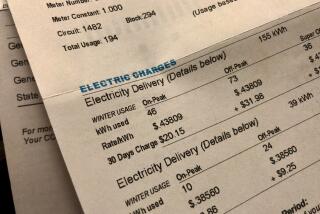Hydroelectric at Capacity, Northwest Is Seeking Alternatives : Resources: The Columbia River provided an energy surplus for all the 1980s. But now the emphasis is on conservation.
- Share via
PORTLAND, Ore. — Water thundering through hydroelectric turbines in dams along the Columbia River provided cheap power that built the Northwest. But the thunder is as loud as it will ever get.
The long era of surplus electricity is over, and the Northwest must face a future of energy limits.
Now the region’s energy planners say economic growth depends on saving energy, not producing it.
“We’re going to have to spend $7 billion by the year 2000 for conservation. That’s a major investment,” said Ed Sheets, executive director of the Northwest Power Planning Council.
Planners have ruled out large coal-fired plants, nuclear generators and additional hydroelectric projects. Coal is considered too dirty, nuclear plants are too costly and risky, and hydro projects are too small.
“Most of the big hydro projects have been developed,” Sheets said. “Even if we could build dams on the 44,000 miles of restricted rivers, we’d get only about 1,000 megawatts.”
Deciding how the region will satisfy its energy needs well into the next century is the council’s main job.
The council was created by the Northwest Power Act of 1980 to coordinate energy development in Oregon, Washington, Idaho and Montana. Its plans and policies are carried out by the Bonneville Power Administration, the U.S. Army Corps of Engineers, the Bureau of Reclamation and the Federal Energy Regulatory Commission--all federal agencies.
The council has developed a 20-year plan that relies heavily on conservation, turbines powered by natural gas, co-generation using waste heat from large factories or mills, regional power exchanges and unproven energy sources such as wind, solar and geothermal power.
“I don’t see another nuclear plant or coal plant in this region in my lifetime,” said Randy Hardy, Bonneville’s chief.
His agency had plenty of electricity to sell until the 1990s arrived. Now it has been forced to turn around its approach to marketing energy and lead the effort to insulate houses, install more efficient lighting in commercial buildings and encourage businesses to find new ways of saving electricity.
“We were in an energy surplus for all the 1980s. It was hard to justify maximum levels of conservation if you didn’t need to save the energy,” Hardy said.
The BPA, as directed by the federal power council, hopes to boost the region’s total energy supply by 1,500 average megawatts by the year 2000. Nearly half that amount must come from conservation.
The agency has been supporting weatherization and energy efficiency programs in residential housing since the early 1980s. But commercial and industrial customers were not interested because power was plentiful and cheap, said John Elizalde, director of the BPA’s resource management division.
Hardy said most of the burden of conservation will fall on the owners of large buildings and manufacturing plants.
“That will be much cheaper than residential conservation,” Hardy said. “You have to insulate a whole lot of houses to get the same savings as replacing one large electric motor in a factory.”
Elizalde predicted that many companies will invest in energy-saving lighting and heating not only to cut costs, but also to improve their corporate image.
“We talk about so-called ‘green’ companies because businesses are starting to understand that consumers value that,” Elizalde said. “I think that what we’re going to see as the decade unfolds is, what is the market value of being energy efficient? If it brings people in the door, if it makes you perceived as a good corporate citizen, that has value, too.”
Most public and private utilities already have conservation programs.
“Our conservation programs previous to 1991 had run around $20 million a year. In 1991 it jumped up to $40 million. In 1992 it jumped to over $50 million in conservation investment,” said Brian Clayton, manager of conservation for Puget Power, based in Bellevue, Wash.
“We’ve been doing it since 1978. So we’re pretty strong believers in conservation up here,” Clayton said.
The emphasis on conservation has forced the utilities, like the BPA, to reverse their thinking. In the past, the more power they sold, the bigger their profits. Now they must sell less and encourage their customers to save even more, a practice known as “decoupling.”
Ratepayers may end up footing the bill, just as taxpayers help pay for the federal government’s conservation programs.
“If we invest money that actually results in less power being used, we’re not only out the money invested but out the revenue from the electricity not used,” said David Heintzman, spokesman for Portland General Electric Co.
“Decoupling is a way to remove the disincentive of selling less,” he said.
The big questions the utilities face, their planners say, are how much cost should the government bear for conservation programs and how much control over policy should it have?
“I’m a strong believer in diversity, in local control. I think we can do a better job of conservation than Bonneville can,” said Phil Sher, managing economist for the Pacific Northwest Generating Cooperative in Portland. The co-op represents 27 rural electric cooperatives with 500,000 customers.
Hardy, Bonneville’s chief, says Sher may be right. Increasing the region’s power supply will take a combination of conservation, diversified energy sources, public awareness, government incentives and long-range planning by utilities.
“The final thing I’d say is we will encourage customers not to rely on our conservation programs, but to do their own,” he said.
More to Read
Sign up for Essential California
The most important California stories and recommendations in your inbox every morning.
You may occasionally receive promotional content from the Los Angeles Times.













